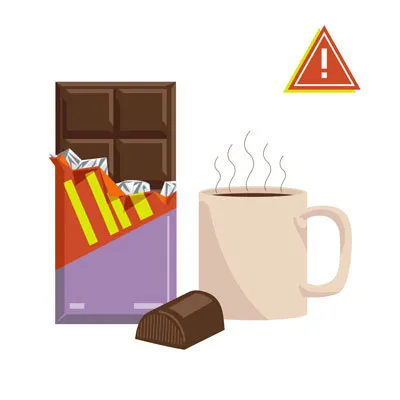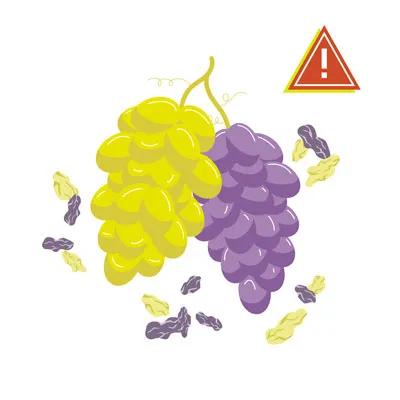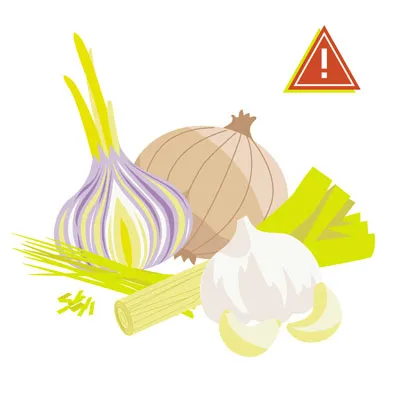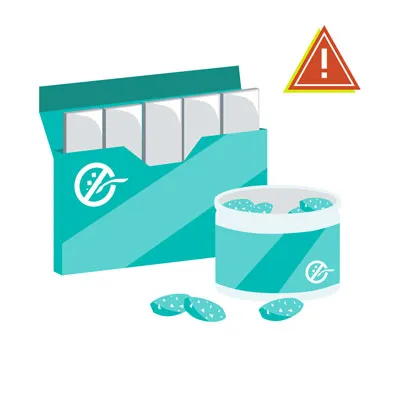As loving pet parents, we always want to share our lives—and sometimes our food—with our furry best friends. However, human foods can be your dog’s best friend or their worst enemy. Many common household items are surprisingly toxic to dogs, even in small amounts, leading to the unfortunate reality that over 401,500 pet poisonings occur annually in the United States. While not all are food-related, everyday foods are significant contributors to these incidents. Understanding what your dog can and cannot eat is crucial for their well-being. This comprehensive guide will serve as your essential “cheat sheet” to help you keep your beloved canine safe and healthy, covering a detailed list of what dogs can’t eat and offering crucial advice on prevention and emergency actions. For a positive contrast, learn more about what human can dogs not eat.
Understanding Why Certain Foods Are Toxic to Dogs
Dogs’ digestive systems and metabolisms are vastly different from humans, explaining why many foods safe for us are harmful to them. Their bodies process certain substances in unique ways. For instance, dogs metabolize the theobromine and caffeine found in chocolate much slower than humans, allowing these substances to build up quickly in their systems, potentially becoming fatal.
While you can easily digest cherries, the cyanide present in their pits, stems, and leaves can pose a problem if ingested by your dog in very large quantities. Additionally, cherry pits are difficult for dogs to digest and can cause diarrhea, making it best to avoid them altogether. Food toxicity can also vary based on a dog’s size, breed, and overall health condition. Therefore, it is always important to consult your veterinarian with any questions regarding foods your dog should avoid.
Comprehensive List of Foods Dogs Cannot Eat
Many common household foods are dangerous, and often toxic, to dogs. Some of the most frequently encountered foods that are bad for dogs include alcohol, avocados, macadamia nuts, grapes and raisins, xylitol, and chocolate. However, your dog should avoid all the items listed below, and remember this is not an all-inclusive list of what dogs can’t eat.
Alcohol
Given their smaller size compared to humans, alcohol can have a much more severe and even deadly effect on dogs. Even minimal amounts can cause harm, with the danger increasing for smaller pets. Symptoms of alcohol poisoning in dogs mirror those in humans, including vomiting, breathing difficulties, coma, or even death.
Apple, Apricot, Cherry, and Plum Seeds/Pits
While the fleshy parts of apples are safe for dogs, the core and seeds are not. Apple seeds contain cyanide, and though small amounts might not be immediately problematic, it’s safest to avoid the core and seeds entirely. Similarly, apricot, cherry, peach, and plum seeds and pits must be avoided. These fruit pits also contain cyanide, which can lead to vomiting, an irregular and fast heartbeat, seizures, coma, and even death, due to red blood cells’ inability to carry oxygen effectively.
Avocado
Avocados are not a good choice for dogs. Historically, there have been reports of dogs suffering myocardial damage after consuming avocados, though these results haven’t been consistently replicated. Avocados are known to cause issues in other mammal species, and an intact avocado pit can cause a dangerous gastrointestinal obstruction in dogs. Therefore, it is best to avoid this food.
Broccoli
Broccoli contains isothiocyanates, which can be harmful to pets in very large doses. While small amounts of broccoli might be occasionally acceptable, it’s generally best to avoid it given the abundance of other healthy and safe food options. Additionally, broccoli stalks can sometimes become lodged in a dog’s throat, leading to an obstruction.
Caffeine and Coffee Grounds
Caffeine contains methylxanthines, which can cause potentially fatal diarrhea, vomiting, seizures, and an irregular heartbeat in dogs. Even accidental ingestion of coffee grounds or highly caffeinated drinks can cause a dog’s heart to race, leading to seizures, tremors, arrhythmia, difficulty breathing, and other severe symptoms.
Chicken & Turkey Skin, Ham, & Other Fatty Cuts of Meat
Fatty cuts of meat, ham, and items like chicken or turkey skin should be discarded rather than given to pets as treats. Their high-fat content makes them bad for dogs, as they can cause acute pancreatitis, a life-threatening illness with severe complications. Additionally, avoid turkey and chicken bones. If these bones splinter, they can obstruct the bowels or cause damage to the stomach or intestines, potentially leading to a fatal abdominal infection.
 A dog looking longingly at a piece of chocolate, representing the danger of chocolate toxicity for pets.
A dog looking longingly at a piece of chocolate, representing the danger of chocolate toxicity for pets.
Chocolate
Chocolate toxicity is a frequent cause of pet poisoning, especially during holidays. Your dog should absolutely not eat any chocolate product. Chocolate contains a lethal component called theobromine, with darker chocolate containing higher amounts. Chocolate also contains caffeine, and some sugar-free chocolates may contain xylitol, both of which are highly toxic to dogs. Dogs and cats cannot metabolize chocolate as effectively as humans. Dark chocolate or baker’s chocolate are the most dangerous, but any type of chocolate can be problematic. Symptoms of chocolate ingestion include hyperactivity, vomiting, diarrhea, pancreatitis, abnormal heart rhythm, and seizures. If your dog consumes any amount of chocolate, no matter how small, contact your veterinarian immediately.
 A bunch of red grapes, illustrating a common fruit that is highly toxic to dogs.
A bunch of red grapes, illustrating a common fruit that is highly toxic to dogs.
Grapes and Raisins
Grapes and raisins are exceptionally dangerous for dogs. These fruits can lead to severe problems such as kidney failure because their tartaric acid is toxic to a dog’s kidneys. Even a few bites can wreak havoc. Symptoms of raisin or grape poisoning include vomiting and diarrhea, loss of appetite, changes in the amount of urine passed, or a complete inability to pass urine.
Macadamia Nuts, Almonds, and Pistachios
Macadamia nuts can cause dogs to suffer numerous painful symptoms, including weakness, overheating, and vomiting. While the precise mechanism of poisoning remains somewhat mysterious, these nuts are definitively toxic to dogs. As few as six macadamia nuts can cause severe poisoning in a small dog. While macadamia nuts are the most dangerous, other nuts like pistachios and almonds can pose choking hazards or become problematic if flavored or spiced.
Milk and Dairy Products
Milk and other dairy products should be evaluated on a case-by-case basis. Some dogs can tolerate milk or dairy products without issue. However, many dogs are lactose intolerant or allergic, and may experience diarrhea and gas if they consume cow’s milk. Ice cream is also unhealthy for dogs due to its high sugar and fat content. Instead of ice cream, try offering your pup frozen bites of healthy fruits that dogs can safely eat. Small quantities of lower-fat cheese can be acceptable as an occasional treat.
Mushrooms
It is always best to exercise caution and avoid feeding your dog mushrooms. Mushrooms contain a variety of toxins that can cause kidney and liver failure, vomiting, diarrhea, hallucinations, and damage to red blood cells. While washed, white mushrooms from the grocery store might be okay, it is probably safer to choose a different treat.
Nutmeg and Cinnamon
Dogs should never be fed foods containing nutmeg. This spice can cause hallucinations and severe vomiting. The responsible compound is myristicin, and its effects are stronger when consumed in high doses or by smaller dogs. If your dog ingests any amount of nutmeg, contact your veterinarian for guidance. Cinnamon should also be avoided, not because it’s toxic, but because it can irritate your dog’s mouth and sometimes lead to low blood sugar, which can have serious health implications for your pup.
 Garlic cloves and onion slices, representing common kitchen ingredients that are highly toxic to dogs.
Garlic cloves and onion slices, representing common kitchen ingredients that are highly toxic to dogs.
Onions, Garlic, Chives, and Leeks
Many pet owners are surprised to learn that herbs belonging to the allium family, such as onions and garlic, are not safe for their pups. Onions and garlic contain sulfoxides and disulfides, which can damage red blood cells and cause anemia in both cats and dogs. Onion and garlic powders are often found in many prepared foods, including baby food, so it’s essential to read labels carefully before serving store-bought food to your pet. In fact, all allium plants, including chives and leeks, can cause potentially fatal anemia in dogs and cats. Certain Japanese dog breeds, such as Akitas and Shiba Inus, are particularly sensitive to allium plants, but these plants are dangerous to all dogs.
Salt
Excessive amounts of salt can disrupt the fluid balance of cells in your dog’s body. Too much salt can lead to tremors, seizures, diarrhea, or even a coma. Whether your dog is begging for a bite of something containing rock salt, homemade play dough, or potato chips, do not let their sad eyes compromise their health.
Spicy Food
Always keep your dog away from spicy food. Hot, spicy food can cause vomiting, stomach ulcers, or diarrhea, which can be painful for your dog and potentially costly if emergency veterinary care is required.
 Sugar-free gum and candies, highlighting the hidden danger of xylitol for dogs.
Sugar-free gum and candies, highlighting the hidden danger of xylitol for dogs.
Sugar-Free Gum and Candy (Xylitol)
Xylitol is an artificial sweetener found in many human foods, including sugar-free gum and candy, and even some sugar-free baked goods. In dogs, however, it can cause a rapid and dangerous drop in blood sugar, leading to weakness and even seizures. Some dogs may also experience liver failure. Dog poisoning cases involving this artificial sweetener are on the rise; the amount of xylitol in just five pieces of gum has the potential to be fatal for a 65-pound dog.
Tomatoes and Raw Potatoes
Tomatoes and potatoes fall into the category of “safe in some forms, unsafe in others.” A ripened red tomato is generally safe for dogs. However, the green parts of the tomato plant contain solanine, which is toxic to dogs, as do green, unripe tomatoes. Potatoes follow a similar pattern. If baked or boiled without additives, they are generally safe in small amounts. However, raw potatoes also contain solanine, making them toxic to dogs.
Tobacco
Tobacco is extremely dangerous and unhealthy for your dog. Exposure to nicotine-containing products can cause a variety of symptoms, including vomiting, diarrhea, rapid or labored breathing, agitation, abnormal heart rate, wobbliness, weak muscles, high or low blood pressure, seizures, and tremors. More significant or frequent exposure to tobacco can lead to blue gums and coma, and ultimately prove fatal. Dogs are naturally curious and might encounter a discarded cigarette on a walk or nose through an ashtray. If your dog ingests tobacco, act quickly and take them to the veterinarian immediately.
 Raw dough rising in a bowl, a common food item that poses a serious risk to dogs.
Raw dough rising in a bowl, a common food item that poses a serious risk to dogs.
Yeast and Raw Dough
Yeast and raw dough are unsafe for dogs for several reasons. Raw dough can expand significantly in your dog’s stomach, causing severe pain and potentially life-threatening conditions like gastric torsion or stomach rupture. Furthermore, the yeast and sugar in raw dough can ferment, producing alcohol and leading to alcohol toxicity. This can quickly become fatal, requiring immediate medical intervention.
Raw Meat
You should never feed your dog raw or undercooked meat. The possible presence of Salmonella or E. coli in raw meat can be harmful to dogs, just as it is to humans. Additionally, dogs can choke on bones present in raw meat.
Rhubarb
Rhubarb, a plant commonly used in desserts, is not safe for pets. Its leaves contain soluble calcium oxalate crystals. If eaten in large enough quantities, these crystals can bind with calcium in the body, causing a dangerous drop in calcium levels and potentially leading to renal failure, which can be life-threatening for your dog. Symptoms include tremors, weakness, drooling, bloody urine, changes in thirst and urination, and vomiting.
Star Fruit
Similar to rhubarb, star fruit also contains soluble calcium oxalate crystals. It is best not to let your dog snack on this fruit.
Flavored Water and Seltzer Water
It’s always safer to give your dog fresh, clean water rather than anything flavored or carbonated. Seltzer and flavored waters can contain added ingredients dangerous to pups, such as sugar or salt. Plain seltzer water might be acceptable in small amounts if urgently needed, but it can lead to gas and bloating. The best and safest option is always plain water.
Foods Safe for Dogs
While the list of what dogs can’t eat is extensive, there are also many safe and healthy foods your dog can enjoy! Some of the safest and most popular choices include dehydrated chicken or beef (in very small amounts), apples (without the core), green beans, and carrots. Explore our detailed guide on what people food can my dog eat and what is best for dogs to eat for more options.
What Dogs Are Most at Risk if They Consume Toxic Foods?
While all dogs should avoid toxic foods, some are more vulnerable than others:
- Small breeds vs. large breeds: Smaller dogs are more susceptible due to their lower body weight, especially to substances like chocolate.
- Puppies: Younger dogs have less developed digestive and immune systems, placing them at greater risk from certain substances, including raw dog food.
- Elderly dogs: Older dogs may face higher risks due to pre-existing health conditions. For example, dogs with other health problems should not be fed raw dog food.
- Dogs with pre-existing conditions: Many pre-existing health conditions, such as diabetes or kidney disease, can put a dog at greater risk.
How to Prevent Dogs from Eating Toxic Foods
Although accidents can happen, proactive steps can significantly minimize the risk of your beloved pup ingesting unsafe human food.
1. Store foods out of reach
Ensure your dog cannot access any toxic foods. Keep dangerous items on high shelves or locked away in cabinets that your pup cannot open.
2. Avoid feeding dogs from your plate
Do not feed your dog from your plate or in the kitchen while you are cooking, even if you just intend to give them a small treat. It is safest to only give your pup treats specifically made for dogs.
3. Educate family members and guests
Educate your family members, including children, and any guests about the importance of not sneaking food to your dog, no matter how tempting it may be.
4. Be careful during holidays
Exercise extra caution during holidays, as the busy atmosphere can make it easy to let your guard down while cooking. If your precautions fail and your dog eats something toxic, be prepared to act quickly. Keep contact information readily available for emergency veterinarians who are open 24/7, including holidays, or for poison control centers.
What To Do if Your Dog Eats Something Toxic
If your dog consumes toxic food, seek help as quickly as possible. You should be familiar with the symptoms of food toxicity so you can promptly recognize if your dog has eaten something harmful. Symptoms vary depending on what your pup ingested and can include listlessness, distress, pain, vomiting, bloody stools, or a bloated stomach that feels hard to the touch, which is a painful condition that can lead to rupture if untreated.
If you observe these symptoms, do the following:
- Call your veterinarian or poison control right away. Timing is crucial, as treatments are typically more successful and hospitalization shorter when a dog receives prompt help.
- Be ready with all important information, such as the type of food eaten, the amount consumed, and the time of ingestion.
- Avoid home remedies unless specifically suggested by your veterinarian, as remedies can vary depending on what was eaten. Even inducing vomiting can be harmful in some cases.
Dog Care Story Can Help You Keep Your Dog Healthy
From understanding what are good foods for dogs to eat to recognizing dangerous foods, keeping track of everything your dog shouldn’t get into can be challenging. Dogs don’t always have the most discerning taste! However, by following this guide and staying vigilant, you can help protect your dog from harmful foods. The good news is that there are plenty of safe and healthy foods for them to enjoy! Discover which ones on our list your dog loves and offer them as treats when they’ve been good. If you’re ever unsure about any foods, always consult with your veterinarian. For advice on when your dog might be reluctant to eat, check out what to feed dog that will not eat.
References
- “Top 10 dog poisons,” Hilary Parker (5/2023), WebMD.
- “What happens if a dog eats chocolate?” (10/2023), Colorado State University.
- “Fruits and vegetables dogs can or can’t eat,” (3/2024), American Kennel Club.
- “What to do if your dog drinks alcohol,” Jerry Klein (7/2023), American Kennel Club.
- “Can dogs eat apples?” Hector Joy (12/2022), PetMD.
- “Can dogs eat plums?” Katie Koschalk (7/2023), Chewy.
- “Avocado (Persea spp) Toxicosis in Animals,” Cristine Hayes (9/2024), Merck Veterinary Manual.
- “People foods to avoid feeding your pets,” (n.d.), ASPCA.
- “People foods dogs can and can’t eat,” (3/2024), American Kennel Club.
- “Can dogs eat nuts?” Amanda Ardente (1/2023), PetMD.
- “Can dogs drink milk?” Sandra C. Mitchell (1/2024), PetMD.
- “Can dogs have nutmeg?” Barri J. Morrison (11/2023), PetMD.
- “Onion, garlic, chive, and leek poisoning in dogs,” Renee Schmid et al. (2024), VCA Animal Hospitals.
- “Can dogs eat tomatoes?” Anna Burke (10/2024), American Kennel Club.
- “Can dogs eat potatoes?” Katherine Ripley (11/2023), American Kennel Club.
- “What to do if your dog eats a cigarette butt,” (6/2023), American Kennel Club.
- “Dough & dogs: Why it’s bad and what you can do,” Lisa Goldstein (7/2024), Preventive Vet.
- “Rhubarb,” (n.d.), Pet Poison Helpline.
- “Can dogs drink carbonated water?” Heather Logue (n.d.), Rover.
- “What fruits can dogs eat?” Ellen Malmanger (2/2024), PetMD.
- “Can dogs have green beans?” Anna Burke (8/2022), American Kennel Club.
- “About pet food safety,” (4/2024), CDC.
